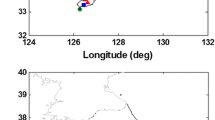Abstract
Integrity design, including fault node design, node probability allocation and fault elimination method design, has been the focus of Satellite Based Augmentation System. At present, most of the researches on integrity allocation are aimed at the range error caused by satellite signal fault. In contrast, fault from delay measurement of the Ionosphere Pierce Point does not directly affect the range, but indirectly affects the delay of IGPs. This may lead to some difference in MERR calculations. In addition, the test statistics of ionosphere anomalies are usually in chi-square form, so the traditional linear hypothesis is no longer valid. In this paper, the above problems are analyzed and the ionosphere related integrity allocation is studied. Taking the Feared Event with a “shift” of the distribution as an example, we first analyze the relationship between protection level integrity risk and the “shift” amount with the concept of Maximum-allowable ERror in Range (MERR). Then according to the Minimum Detectable Error (MDE), the monitor threshold and the expression of missed detection risk are obtained for the chi-square detection. Finally, the relationship between integrity risk and variance is analyzed, and the general methods to be followed in integrity design are given. The conclusions given in this paper can guide the BD SBAS integrity design.
Access this chapter
Tax calculation will be finalised at checkout
Purchases are for personal use only
Similar content being viewed by others
References
Grewal, M.S., Schempp, T., Habereder, H.: Overview of the SBAS integrity design. In: The European Navigation Conference, GNSS 2003, Graz, Austria, April 22–25 (2003)
Watt, G.T., De La Cruz, C.L., Habereder, H.L., Heine, D.R.: Proving SBAS integrity through fault tree based systems engineering. In: ION GPS/GNSS, Portland, USA, September 9–12 (2003)
Shively, C.A.: Derivation of acceptable error limits for satellite signal faults in LAAS. In: Proceedings of the Institute of Navigation ION GPS-1999 (September 1999)
Rife, J., Phelts, R.E.: Formulation of a time-varying maximum allowable error for ground-based augmentation systems. IEEE Trans. Aerosp. Electron. Syst. 44(2), 548–560 (2008). ION NTM 2006
Soualle, F., Mink, M., Braun, R.: Methodology for the design of integrity barriers in a regional augmentation satellite system. In: ION GNSS+ 2015, Tampa, USA, September 14–18 (2015)
RTCA Special Committee 159: Minimum operational performance standards for airborne equipment using global positioning system/wide area augmentation system. RTCA/DO-229C (November 2001)
Sparks, L., Blanch, J., Pandya, N.: Estimating ionospheric delay using kriging: 1. Methodology. Radio Sci. 46(06), 1–13 (2016)
Walter, T., Hansen, A., Blanch, J., et al.: Robust detection of ionospheric irregularities. In: Proceedings of the 13th International Technical Meeting of the Satellite Division of the Institute of Navigation (ION GPS 2000), Salt Lake City, Utah, 19–22 September, 2000, pp. 209–218 (2000)
Chen, J.: Research of GPS Integrity Augmentation (2001)
DeCleene, B.: Defining pseudorange integrity – overbounding. In: Proceedings of ION GPS 2000, pp. 1916–1924 (2000)
Rife, J., Pullen, S., Pervan, B., Enge, P.: Paired overbounding for nonideal LAAS and WAAS error distributions. IEEE Trans. Aerosp. Electron. Syst. 42(4), 1386–1395 (2006)
Zhang, Y., Xiao, Z., Li, P., et al.: Conservative sensor error modeling using a modified paired overbound method and its application in satellite-based augmentation systems. Sensors 19(12), 2826 (2019)
Enge, P., Walter, T., Pullen, S., et al.: Wide area augmentation of the global positioning system. Proc. IEEE 84(8), 1063–1088 (1995)
Blanch, J.: Using kriging to bound satellite ranging errors due to the ionosphere. Ph.D. dissertation, The Department of Aeronautics and Astronautics, Stanford University, USA (2003)
Pandya, N., Gran, M., Paredes, E.: WAAS performance improvement with a new undersampled ionospheric gradient threat model metric. In: ION NTM 2007, pp. 291–304 (2007)
Author information
Authors and Affiliations
Corresponding author
Editor information
Editors and Affiliations
Rights and permissions
Copyright information
© 2020 The Editor(s) (if applicable) and The Author(s), under exclusive license to Springer Nature Singapore Pte Ltd.
About this paper
Cite this paper
Zhang, Y., Tang, X., Huang, Y., Huang, L., Ou, G. (2020). Derivation of Integrity Allocation for Satellite Based Augmentation System Ionosphere Monitors. In: Sun, J., Yang, C., Xie, J. (eds) China Satellite Navigation Conference (CSNC) 2020 Proceedings: Volume II. CSNC 2020. Lecture Notes in Electrical Engineering, vol 651. Springer, Singapore. https://doi.org/10.1007/978-981-15-3711-0_65
Download citation
DOI: https://doi.org/10.1007/978-981-15-3711-0_65
Published:
Publisher Name: Springer, Singapore
Print ISBN: 978-981-15-3710-3
Online ISBN: 978-981-15-3711-0
eBook Packages: EngineeringEngineering (R0)




